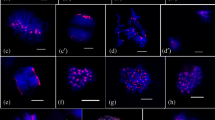Abstract
Plant (Secale cereale, Triticum aestivum) and animal (Eyprepocnemis plorans) meiocytes were analyzed by indirect immunostaining with an antibody recognizing histone H3 phosphorylated at serine 10, to study the relationship between H3 phosphorylation and chromosome condensation at meiosis. To investigate whether the dynamics of histone H3 phosphorylation differs between chromosomes with a different mode of segregation, we included in this study mitotic cells and also meiotic cells of individuals forming bivalents plus three different types of univalents (A chromosomes, B chromosomes and X chromosome). During the first meiotic division, the H3 phosphorylation of the entire chromosomes initiates at the transition from leptotene to zygotene in rye and wheat, whereas in E. plorans it does so at diplotene. In all species analyzed H3 phosphorylation terminates toward interkinesis. The immunosignals at first meiotic division are identical in bivalents and univalents of A and B chromosomes, irrespective of their equational or reductional segregation at anaphase I. The grasshopper X chromosome, which always segregates reductionally, also shows the same pattern. Remarkable differences were found at second meiotic division between plant and animal material. In E. plorans H3 phosphorylation occurred all along the chromosomes, whereas in plants only the pericentromeric regions showed strong immunosignals from prophase II until telophase II. In addition, no immunolabeling was detectable on single chromatids resulting from equational segregation of plant A or B chromosome univalents during the preceding anaphase I. Simultaneous immunostaining with anti-tubulin and anti-phosphorylated H3 antibodies demonstrated that the kinetochores of all chromosomes interact with microtubules, even in the absence of detectable phosphorylated H3 immunosignals. The different pattern of H3 phosphorylation in plant and animal meiocytes suggests that this evolutionarily conserved post-translational chromatin modification might be involved in different roles in both types of organisms. The possibility that in plants H3 phosphorylation is related to sister chromatid cohesion is discussed.
Similar content being viewed by others
Author information
Authors and Affiliations
Corresponding author
Rights and permissions
About this article
Cite this article
Manzanero, S., Arana, P., Puertas, M. et al. The chromosomal distribution of phosphorylated histone H3 differs between plants and animals at meiosis. Chromosoma 109, 308–317 (2000). https://doi.org/10.1007/s004120000087
Received:
Revised:
Accepted:
Published:
Issue Date:
DOI: https://doi.org/10.1007/s004120000087




